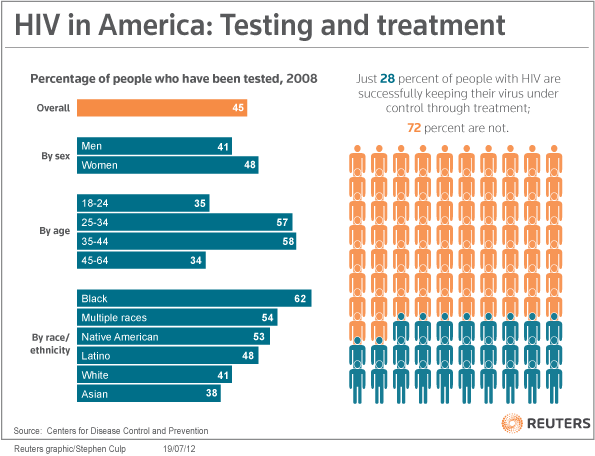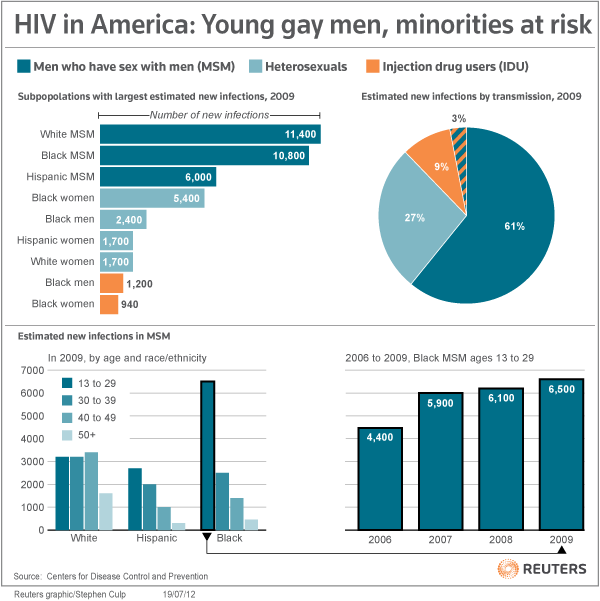
CHICAGO/WASHINGTON - As a gay black man growing up in Chicago's infamous Cabrini Green public housing project, Arick Buckles knows first-hand how the stigma of HIV can keep people infected with the virus from seeking treatment.
It took him six years after he tested positive for the human immunodeficiency virus, or HIV, to get care. By then, Buckles was frail and wore turtleneck sweaters to hide his severely swollen lymph nodes.
"I didn't want to accept it was the HIV that was disfiguring my face, my neck. It was visible," Buckles said. He finally sought care after suffering pneumocystis pneumonia, a lung infection that strikes HIV patients as their immune systems weaken.
The predominantly black housing project where Buckles grew up was such a hub of crime and poverty that the city tore it down several years ago.
"We thought growing up in Cabrini Green that it was a gay disease. If I were to disclose my status, I felt my homosexuality would be outed," said Buckles, 40, who was so fearful of that prospect that he kept his HIV status, and his sexual orientation, in the closet.
"It's looked upon as disgraceful" in the black community, he said.
Buckles' tale is still too common, despite widespread US efforts to foster awareness of the virus that causes AIDS and its treatment over the last three decades, says Dr Kevin Fenton, director of the National Center for HIV/AIDS Prevention at the US Centers for Disease Control and Prevention (CDC).
"Stigma is a huge issue," Fenton said. It can keep people from getting tested, and for those who know they are HIV positive, it can keep them from getting the treatment they need.
He said stigma affects a broad swath of communities in different forms, but for many blacks in America, it exists on top of poverty, poor access to treatment and poor outreach for effective prevention services.
HIV transmission rates have fallen from 130,000 new infections per year during the epidemic's peak in the mid-1980s to 50,000 a year, a level little changed since the mid-1990s.
Part of the problem is that many Americans are infected and do not know it. Of the estimated 1.1 million Americans living with HIV, nearly one in five of those individuals remain undiagnosed.
 |
Up to 44 percent of new infections are clustered in 12 major cities, including Chicago, Washington, New York and Los Angeles, CDC data show. Within these communities, HIV rates are highest among blacks, Hispanics and gay and bisexual men of all races.
CDC researchers will present the latest US data this week at the International AIDS Society's AIDS 2012 conference in Washington, where scientists will gather to discuss better ways to prevent, treat and seek a cure for the disease.?
Blacks, gays and HIV
According to a report released last week by the Black AIDS Institute, black gay and bisexual men make up one in 500 Americans overall, but account for one in four new HIV infections in the United States.
It found that by the time a black gay man reaches 25, he has a one in four chance of being infected with HIV. By age 40, he has a 60 percent chance of being infected.
Fenton said there is nothing unique about blacks that make them more vulnerable to HIV infection. Once higher infection rates are seen in a community, the chances of new members becoming infected are simply higher.
"What we believe is that the infection is becoming concentrated in these minority groups as a reflection of the social and structural drivers of health inequalities overall," he said.
A CDC study published on Friday in the Lancet medical journal found that black men who have sex with men in the United States are 72 times more likely than the general population to be HIV-positive.
HIV-positive gay and bisexual black men in the United States are 22 percent less likely than other HIV-positive gay and bisexual men to get treatment, the team said. They are also less likely to have health insurance, which is key because HIV drugs lower the amount of virus in the body and can significantly reduce the risk of transmission.
Lack of access is just part of the story in the African American communities Buckles now serves as an outreach worker at Chicago House, a social service agency that provides housing and support services to HIV-affected and at-risk families.
"We figure if we get these people housed, they are able to address their HIV status," he said.
More tests, more hope?
In Washington, a city with one of the highest infection rates in the country, CDC has been working with local health officials to increase testing.
Local health officials launched an HIV screening program in 2006 that expands testing to places like the department of motor vehicles, where individuals can get tested while they wait for a driver's license.
Since its start in 2006, HIV testing in Washington is up 400 percent, rising from fewer than 30,000 tests in 2006 to 122,000 in 2011.
At United Medical Center in the predominantly black, southeast part of the nation's capital, nurses saw they needed to reach a wide range of people who ordinarily may not get tested. They began offering free HIV testing through the center's emergency room 24 hours a day.
Patients get immediate results and those who test positive are connected with care before leaving.
Donna Landers, a 47-year-old grandmother, sought emergency care at the clinic for abdominal pain in October and agreed to have an HIV test as well. She had a negative test just two months earlier, so her positive result was a shock.
"I was stunned," said Landers, who is black. She believes she got the virus from her husband.
Although she felt quickly embraced by the clinic's staff, many others judge her, including some relatives, Landers said.
"My sister used to hug me; now she don't."
Dr. Lisa Fitzpatrick, who sees patients at the center after they are diagnosed, said more doctors need to make testing routine, especially in the black community.
"There's no reason why I should test someone for diabetes and high cholesterol and not HIV," she said.
Fitzpatrick, who is black, said many of her patients have full-blown AIDS because they've avoided or delayed treatment. She sees religious influences making many people in the black community wary of discussing HIV and sex. They consider it a gay-only issue.
And the young gay men she sees are so convinced they will get HIV anyway that "they're not terribly concerned about it."
 |
In New York, a group of mostly black, gay and HIV-positive men is trying to break the silence by handing out condoms and trying to educate other young gay men at risk.
Sexy With A Goal, or SWAG, is an affiliate of the AIDS Service Center of New York City. The group hopes its efforts will help young men understand "safer sex is sexy."
New efforts
The CDC just launched a new national campaign aimed at overcoming the stigma called "Let's Stop HIV Together." Ads start running this week in six cities heavily affected by HIV, with others to be added later.
Other federal efforts may help. The Food and Drug Administration this month approved the first at-home HIV test that some experts say may help reach people who don't want to be seen at a clinic.